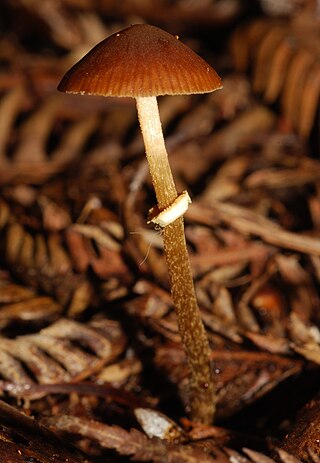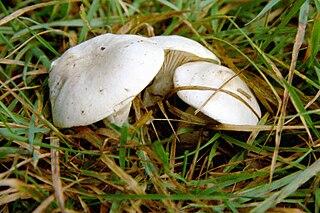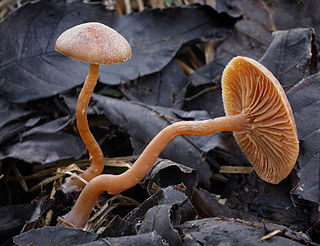Related Research Articles

Conocybe rugosa is a common species of mushroom that is widely distributed and especially common in the Pacific Northwest of the United States. It grows in woodchips, flowerbeds and compost. It has been found in Europe, Asia and North America. It contains the same mycotoxins as the death cap mushroom. Conocybe rugosa was originally described in the genus Pholiotina, and its morphology and a 2013 molecular phylogenetics study supported its continued classification there.

Pholiotina cyanopus is a species of fungus that contains psychoactive compounds including psilocybin and the uncommon aeruginascin. Originally described as Galerula cyanopus by American mycologist George Francis Atkinson in 1918. It was transferred to Conocybe by Robert Kühner in 1935 before being transferred to Pholiotina by Rolf Singer in 1950. A 2013 molecular phylogenetics study found it to belong to a group of species currently assigned to Pholiotina that are more closely related to Galerella nigeriensis than to Pholiotina or Conocybe. It is likely that it will be moved to a different genus in the future, but this has not happened yet.

Arrhenia is a genus of fungi in the family Hygrophoraceae. Arrhenia also includes species formerly placed in the genera Leptoglossum and Phaeotellus and the lectotype species itself has an unusual growth form that would not normally be called agaricoid. All of the species grow in association with photosynthetic cryptogams such as mosses, including peat moss, and alga scums on decaying wood, and soil crusts consisting of mixes of such organisms. Typically the fruitbodies of Arrhenia species are grey to black or blackish brown, being pigmented by incrusting melanized pigments on the hyphae.

Pholiotina is a genus of small agaric fungi. It was circumscribed by Swiss mycologist Victor Fayod in 1889 for Conocybe-like species with partial veils. The genus has since been expanded to include species lacking partial veils.

Clitopilus is a genus of fungi in the family Entolomataceae. The genus has a widespread distribution, especially in northern temperate areas. Although a 2008 estimate suggested about 30 species in the genus, a more recent publication (2009) using molecular phylogenetics has redefined the genus to include many former Rhodocybe species.

Descolea is a genus of fungi in the family Bolbitiaceae. Described by mycologist Rolf Singer in 1952, the widespread genus contains about 15 species. It was formerly placed in the family Cortinariaceae because of its limoniform basidiospores and its ectomycorrhizal lifestyle. A 2013 molecular phylogenetics study by Tóth et al. found it to be closely related to the genus Pholiotina The genus Pseudodescolea, erected for the single Descolea-like species Pseudodescolea lepiotiformis, was formerly considered distinct until a 1990 study found it to be a synonym of Descolea antarctica.

Tyromyces is a genus of poroid fungi in the family Polyporaceae. It was circumscribed by mycologist Petter Karsten in 1881. The type species is the widely distributed Tyromyces chioneus, commonly known as the white cheese polypore. The phylogenetic position of Tyromyces within the Polyporales is uncertain, but it appears that it does not belong to the "core polyporoid clade". Tyromyces is polyphyletic as it is currently circumscribed, and has been described as "a dumping place for monomitic white-rot species with thin-walled spores."

Tubaria is a genus of fungi in the family Tubariaceae. The genus is widely distributed, especially in temperate regions. Tubaria was originally named as a subgenus of Agaricus by Worthington George Smith in 1870. Claude Casimir Gillet promoted it to generic status in 1876. The mushrooms produced by species in this genus are small- to medium-sized with caps ranging in color from pale pinkish-brown to reddish-brown, and often with remnants of the partial veil adhering to the margin. Mushrooms fruit on rotting wood, or, less frequently, in the soil. There are no species in the genus that are recommended for consumption.
References
- ↑ "Species Fungorum - Search Page". www.speciesfungorum.org. Retrieved 2024-02-28.